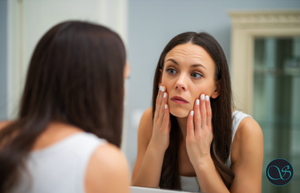Overview:
Aging, genetics, fatigue and more can all cause dark circles under your eyes. But they usually aren’t a sign of a medical problem. While they aren’t typically a cause for concern, they may be cosmetically unappealing to some people.
Dark circles under your eyes mean the area of skin below your eyes looks darkened. This area may appear as shades of blue, purple, or brown depending on your natural skin color. Dark circles under your eyes may make you look tired or older than you are. There are many different treatments for dark circles, but the first step is to identify what’s causing them.
Causes:
It’s important to distinguish dark circles or puffy eyes caused by loss of volume or your basic anatomy (both of which can be hereditary) from under-eye wrinkles or dark circles caused by hyperpigmentation in the area.
- Increased pigmentation (melanin)- more common in people with darker skin types
- Loss of fatty tissue in the eyelid or around the eye (aging process)
- Bulging fat and muscle loss
- Contact or atopic dermatitis causing increased pigmentation- common in people with allergies who frequently rub their eyes.
- Thin, translucent skin- blood vessels cause a purple discoloration that look like dark circles
- Shadowing due to anatomic shape of the orbit
Who gets dark circles?
The elderly (but they are also a common complaint in adolescents), people of non-white ethnic background, and people with a genetic predisposition to dark circles under the eyes. Dark circles may be more noticeable at times due to fatigue or lack of sleep, dehydration, and excessive alcohol or drug use.
Treatment:
- Topical creams- Bleaching creams, such as hydroquinone, can also help lighten the appearance of dark circles. Sensitive retinol, such as, Siperstein Retinol Plus Eye Cream, may improve dark circles caused by hyperpigmentation (ingredients: Retinol, Vitamin K, and Arnica).
- Laser therapy- Lasers such as laser resurfacing for skin laxity and skin wrinkles causing dark circles.
- Injectables- Hyaluronic acid fillers will help under eye darkness that is a result of skin laxity from aging or genetics, by adding volume to fill the hollowness of the dark circles. Fillers also help with under eye dark circles caused by blood vessels by lifting the skin up and away from the vessels, so that they don’t shine through as easily. The benefits of fillers for wrinkles or dark circles include lightening the appearance of the skin and restoring volume under the eyes.
- Surgery- lower eyelid blepharoplasty may improve the area if the dark circles are caused by shadowing from excess skin.
- Non-medicinal- Get more sleep, sleep on pillows to elevate your head, cold compresses to help decrease inflammation and constrict blood vessels, makeup concealer to camouflage dark coloring. Facials may also help promote blood flow to the under eye area.
Prevention:
Protecting your skin with sunscreen from the harmful sun rays will keep the skin barrier healthy and less prone to thinning skin from sun damage. Treating allergies that cause itchy eyes to avoid excess itching or rubbing of the skin. Get a reasonable amount of sleep every night, at least 7 hours. Find ways to manage and minimize your stress. Cut down on alcohol consumption. Quit smoking and using tobacco (smoking speeds up the aging process which contributes to dark circles).
Take away points:
If you’re interested in managing dark circles, the first step is to talk to your dermatologist to diagnose what’s actually causing the issue. And, remember, it may be due to a combination of factors, like hyperpigmentation coupled with anatomy and lifestyle factors (dehydration and sleep deprivation, as we mentioned earlier, for example).


